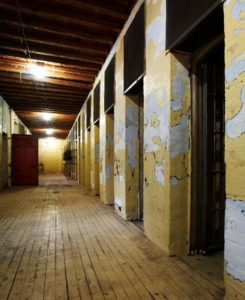
THE COP KILLER AND HIS LAWYER
A recent obituary in the Globe and Mail highlighted the many facets of the career of Clare Elvet Lewis, who died in Toronto on October 24, 2020, at the age of 83. One of the various (and earliest) hats he wore in the course of his professional life was that of defence lawyer. It was in this role that he met up with a small-time criminal named René Vaillancourt, who cruised into Toronto from his native Montreal in January 1973 to rob a bank.
After spending the night of January 31 at the Gladstone Hotel, Vaillancourt drove across town to his target of choice: a Canadian Imperial Bank of Commerce branch at Danforth and Coxwell avenues in the east end. The 24-year-old was out on bail at the time on six charges, including possession of a dangerous weapon, car theft, and possession of stolen property. Reportedly, his specialty was stealing colour televisions from houses, stores and taverns in his home town. But he had become tired of the meagre pickings from his existing criminal activities. “I came to Toronto because the banks have more money in them,” he said later. “I was getting only $200 for B and Es [breaking and entering].” His optimistic assessment was spot on: using a .38 Smith & Wesson Special he had purloined from a policeman’s house in Montreal, he held up a teller at the CIBC branch and made off with almost $1800.
After dumping the 1965 Pontiac Parisienne he had stolen to use as a getaway car, Vaillancourt headed back to his own vehicle parked on nearby Drayton Avenue. There he encountered Leslie Maitland, a 35-year-old police officer who was in the area with trainee constable Brian McCullum investigating a robbery — probably the one Vaillancourt had just committed. “When I seen that he was coming for me I took out my gun…. I waved my gun at him…. He kept coming towards me. He wanted to catch me. I just shot and he fell down on the sidewalk,” Vaillancourt told police.
The bullet severed Maitland’s aorta and he was probably dead before he hit the ground. Vaillancourt shot him again, and followed this up by firing four times at McCullum, who, as a trainee, was unarmed. It was the young cop’s lucky day. He took shelter behind the police cruiser and all the bullets missed their target. But, as he grimly noted, “I could feel the spray of glass [from shattered car windows] on my face.”
Vaillancourt was captured while trying to escape in a taxi. “I killed the policeman,” he told investigating officers. “I want to get it over as fast as possible. I’ll plead guilty and draw my sentence. They will hang me for this but better that than being in jail all my life.” By the time his trial opened in September 1973, Vaillancourt had changed his mind. He pleaded not guilty.
 Vaillancourt had clearly pulled the trigger and he had clearly killed Leslie Maitland. More than 20 witnesses were prepared to attest to that. However, the accused’s lawyer, Clare Lewis, tried to prove “that Vaillancourt’s rational mind had disintegrated and that he could not realize the nature of the act that he had committed.” Psychiatrists and psychologists called by the defence testified that Vaillancourt had suffered brain damage at birth. He was described as impulsive, easily distracted, sadistic as a child, and sexually deviant; all of which, those experts argued, pointed to a diagnosis of minimal brain dysfunction. The jury preferred the version of Dr. Joseph Marotta, a neurologist at Toronto’s St. Michael’s Hospital, who found no evidence of abnormality in a neurological assessment of the defendant. Vaillancourt was found guilty of murder and sentenced to death by hanging — which was, back then, the penalty for the slaying of a police officer in Canada.
Vaillancourt had clearly pulled the trigger and he had clearly killed Leslie Maitland. More than 20 witnesses were prepared to attest to that. However, the accused’s lawyer, Clare Lewis, tried to prove “that Vaillancourt’s rational mind had disintegrated and that he could not realize the nature of the act that he had committed.” Psychiatrists and psychologists called by the defence testified that Vaillancourt had suffered brain damage at birth. He was described as impulsive, easily distracted, sadistic as a child, and sexually deviant; all of which, those experts argued, pointed to a diagnosis of minimal brain dysfunction. The jury preferred the version of Dr. Joseph Marotta, a neurologist at Toronto’s St. Michael’s Hospital, who found no evidence of abnormality in a neurological assessment of the defendant. Vaillancourt was found guilty of murder and sentenced to death by hanging — which was, back then, the penalty for the slaying of a police officer in Canada.
After their brief meeting in the early 1970s, the lives of the criminal lawyer and the cop killer followed very different trajectories. Lewis went on to occupy a myriad of other roles on the right side of the law: notably, judge, police commissioner and creator of the Special Investigations Unit (SIU) that investigates the police, and Ontario ombudsman. He was on the Ontario Review Board in 2010 when a debilitating stroke ended his public life.
Vaillancourt was sent to death row at Toronto’s notorious Don Jail to await execution. He was still there a full 692 days later when he learned that he would not hang on October 31, 1975. He had been granted a nine-month stay of execution by solicitor-general Warren Allmand, pending the introduction of a bill abolishing capital punishment in Canada. On July 14, 1976, Bill C-84 squeaked through Parliament by a margin of seven votes, effectively putting the kibosh on the death penalty in Canada.
Vaillancourt’s sentence was commuted to life in prison with no chance of parole for 25 years. After his transfer to a federal penitentiary, Vaillancourt developed a new set of skills: he became a drug trafficker and ran an illicit mail-order business, abetted by his bewildered mother. He traded his own drug dependence for an addiction to computers. But his greatest claim to fame must surely be that he was the last convicted murderer ever to await execution on death row in the Don Jail.